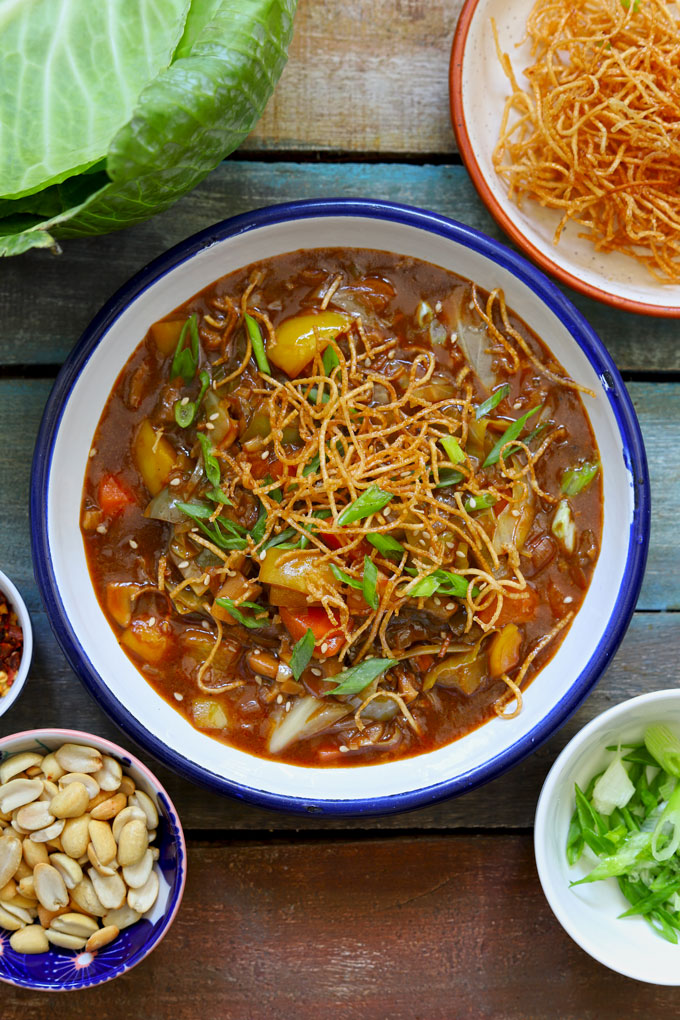
Conlin, Bacon, Beans and Galantines: Food and Foodways on the Western Mining Frontier, University of Nevada Press: Reno 1986, pp.
^ "Chop Suey: From Chinese Food to Chinese American Food", Chinese America: History and Perspectives 87 (1987): 91–93. Chang, Food in Chinese Culture: Anthropological and Historical Perspectives, Yale, 1977. Anderson, "Guangzhou (Canton) Cuisine", in Solomon H. Anderson, The Food of China, Yale University Press, 1990, ISBN 0300047398, p. For example, in the classic novel Journey to the West (circa 1590), Sun Wukong tells a lion-monster in chapter 75: "When I passed through Guangzhou, I bought a pot for cooking za sui – so I'll savour your liver, entrails, and lungs." The term za sui (杂碎) is found in newer Chinese-English dictionaries with both meanings listed: cooked entrails, and chop suey in the Western sense. In earlier periods of Chinese history, chop suey or chap sui in Cantonese, and za sui, in Mandarin, has the different meaning of cooked animal offal or entrails. In 1898, it is described as "A Hash of Pork, with Celery, Onions, Bean Sprouts, etc." ĭuring his travels in the United States, Liang Qichao, a Guangdong (Canton) native, wrote in 1903 that there existed in the United States a food item called chop suey which was popularly served by Chinese restaurateurs, but which local Chinese people do not eat, because the cooking technique is "really awful". Ĭhop suey appears in an 1884 article in the Brooklyn Eagle, by Wong Chin Foo, "Chinese Cooking", which he says "may justly be so-called the 'national dish of China'." An 1888 description states it was a "staple dish for the Chinese gourmand is chow chop svey, a mixture of chickens' livers and gizzards, fungi, bamboo buds, pigs' tripe, and bean sprouts stewed with spices." An 1896 newspaper report states: "Chow chop suey is a sort of stew made of chicken's livers and gizzards, calves' tripe, bean sprouts, celery and 'meu', which is a sort of Chinese first cousin to macaroni". There is no good evidence for any of these stories. To avoid a beating, the cook threw leftover meat and vegetables into a wok and served it to the miners, who loved it and asked what dish it was-he replied "chopped sui". Coincidentally, both restaurants are now named Far East Café.Īnother myth is that, in the 1860s, a Chinese restaurant cook in San Francisco was forced to serve something to drunken miners after hours, when he had no fresh food. Restaurants like this are now rare, but were once a common sight in the United States. Yu speculates that shrewd Chinese American restaurant owners took advantage of the publicity surrounding his visit to promote chop suey as Li's favorite. Yet recent research by the scholar Renqui Yu led him to conclude that "no evidence can be found in available historical records to support the story that Li Hung Chang ate chop suey in the United States." Li brought three Chinese chefs with him, and would not have needed to eat in local restaurants or invent new dishes in any case. 
Another story is that Li wandered to a local Chinese restaurant after the hotel kitchen had closed, where the chef, embarrassed that he had nothing ready to offer, came up with the new dish using scraps of leftovers. Another tale is that it was created during Qing Dynasty premier Li Hongzhang's visit to the United States in 1896 by his chef, who tried to create a meal suitable for both Chinese and American palates. One account claims that it was invented by Chinese American cooks working on the transcontinental railroad in the 19th century. In Chinese Indonesian cuisine/dutch chinese indonesian cuisine it is known as cap cai (tjap tjoi) (雜菜, "mixed vegetables") and mainly consists of vegetables.įilipino chop suey, introduced during the American colonial period of the Philippines

It is typically served with rice but can become the Chinese-American form of chow mein with the substitution of stir-fried noodles for rice.Ĭhop suey has become a prominent part of American Chinese cuisine, Filipino cuisine, Canadian Chinese cuisine, German Chinese cuisine, Indian Chinese cuisine, and Polynesian cuisine.

For other uses, see chop suey (disambiguation) Chop sueyĬhop suey ( / ˈ tʃ ɒ p ˈ s uː i/) is a dish in American Chinese cuisine and other forms of overseas Chinese cuisine, consisting of meat (usually chicken, pork, beef, shrimp or fish) and eggs, cooked quickly with vegetables such as bean sprouts, cabbage, and celery and bound in a starch-thickened sauce. For the New England dish, see American chop suey.







 0 kommentar(er)
0 kommentar(er)
